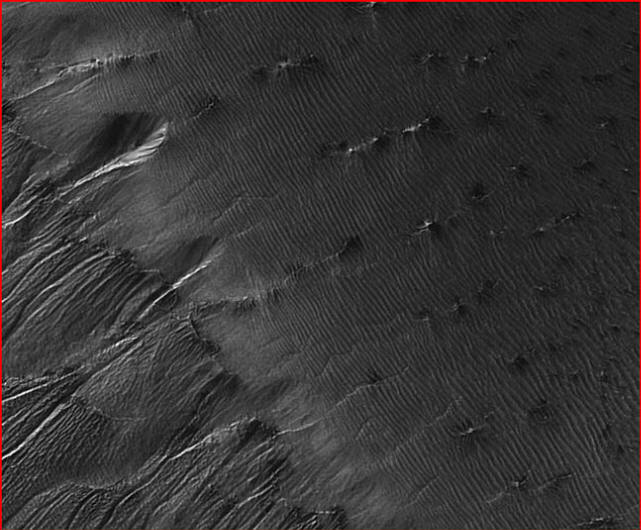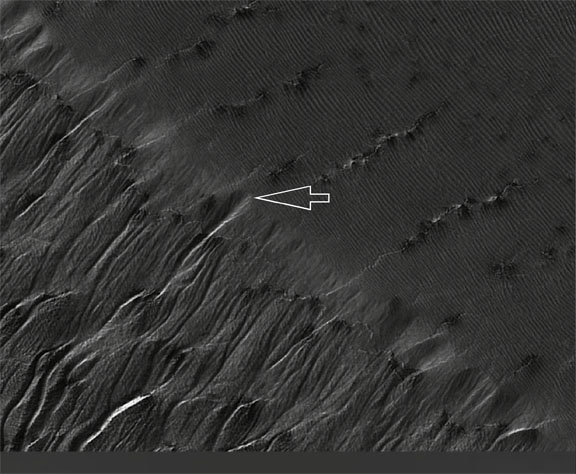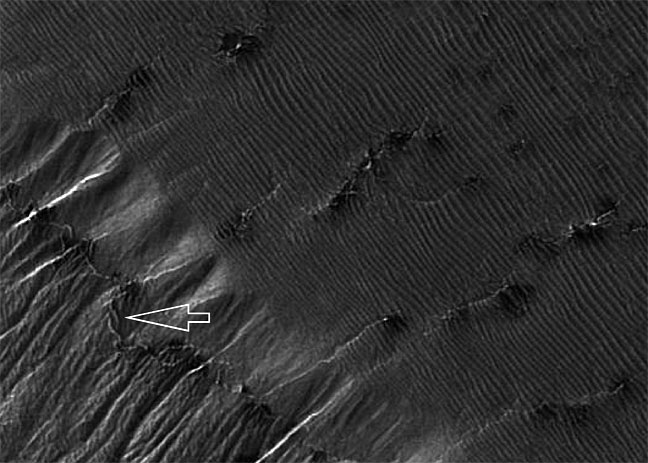
home •
about •
essential guide •
picture of the day •
thunderblogs •
news •
multimedia •
predictions •
products •
get involved •
contact
picture of the day archive subject index
The picture above is from a giant HiRISE image of a towering “sand dune” in Russell Crater on Mars. Depicted
is the crest of the dune, looking like no dune on Earth and posing numerous enigmas for planetary scientists.
Credit: NASA/JPL/HiRISE
May 18, 2007
The "Dark Spots" of Russell CraterThe latest close-up images of the Russell Crater 'dunes' offer new opportunities to test the electrical hypothesis. Among the mysteries: dark nodules occupying the crest of a giant dune from which unexplained "gullies" emerge.
In the previous TPOD in this series, we presented a small section of a very large, high resolution HiRISE image titled “Channels on Dunes in Russell Crater.” Pictured above is a small segment of the dune crest featured in the image. (This is the area enclosed in the red square in the thumbnail of the full image below).
For anyone browsing the huge HiRISE image, it should be immediately clear that the dunes of Russell Crater present feature after feature that will never be reconciled with NASA’s earlier expositions on the mysteries. No possibility remains for reducing the “dunes” to wind blown sand in an electrically neutral atmosphere, or the “gullies” to erosion by fluid flow.
In their attempts to explain the channels by fluid erosion, NASA scientists isolate one enigma from all of the others. Our claim, on the other hand, is that every feature previously noted (here and here), down to the most finite etching of the surface, will find its explanation in electric discharge and electrostatic sculpting. The crest of the formation, we contend, has served as a “lightning rod” for electrical activity. The ravines defy the principles of fluid erosion because they were cut by "streams" of charged particles.
In the portion of the image shown here, the scalloped appearance of the crest stands out, but not as an isolated feature. While standard theory will see “avalanches,” we envision cylindrical arrays of current filaments acting on the crest, to be pinched down into more narrow plasma columns that carved some of the more prominent gullies (pictured below). Clearly the activity was complex, but there is every reason to be confident in the electrical interpretation of the scene as a whole. Our claim is that this interpretation will account precisely for what NASA scientists have consistently overlooked. Of course, anything we offer at this early juncture must be taken as tentative, but we are confident that the more closely the images are examined, the more convincing will be the electrical explanation.
It is evident, for example, that the action of charged particles created a region of charge imbalance a short distance beneath the crest. Here, charge redistribution is apparent in the filamentary and braided ribbons running horizontally along the embankment. It is apparent that something akin to St. Elmo’s Fire left its embossed signature on the surface--a feature so far from standard theory that NASA’s investigators seem not to have even seen it. A small portion of the braided filaments is highlighted by the arrow in the image below. What is such a feature doing on a “sand dune”?
In its description of the scene, the authors of the HiRISE page write, “Distinct dark spots are located near where the channels seem to originate.” And that is all they have to say. But is it really possible to separate the dark nodules configured on the crest from the embossed braiding running along the embankment close to the crest?
If the crest was the focal point of discharge, at times diffuse and at others focused by plasma pinching, the dark spots in the picture above could be one of the best tests of the electrical hypothesis. Seen electrically, they are the focal points of diffuse discharge, where surface material was fused into dark, but more reflective, glassified clumps, a counterpart to the bumps and blisters on lightning arrestor caps. Look closely throughout the highest-resolution HiRISE image and you will see subtle spidery filaments radiating from the darkened clumps, as might be expected of charge redistribution in the form of Lichtenberg figures--a key observation to which we have already alluded in our earlier discussion of Martian spiders, and one to which we shall return with greater clarity in the present series.
Closely associated electrodynamically are the shallow ravines neatly etched into the surface and connecting the dark nodules, in a process that mysteriously ignored the (relatively) minuscule dunes they cut across. These secondary, but undeniably organized ravines emphasize the importance of seeing the dark spots in terms of dynamic connection. Logically, the ravines cannot be isolated from the events that created the nodules. In narrow-angle close-ups its easy to see random placement of the nodules, but when the scene is viewed in its larger context, it is clear that their placement is not random. Consider the large HiRISE “browse” image here. This image makes clear that the tiny ravines (which can only be seen in the highest-resolution image)--and the dark nodules they connect--are aligned in the direction of the spectacular ravines running down the embankment to the lower left.
How, then, can one justify an approach that attempts to explain the ravines in improbable isolation from the other, equally “mysterious” features of the region?
Coming May 20: “Dalmatian Spots” of Mars’ South Pole
![]()
home •
thunderblogs •
forum •
picture of the day •
resources •
team •
updates •
contact us
EXECUTIVE EDITORS:
David Talbott, Wallace Thornhill
MANAGING EDITORS:
Steve Smith, Mel Acheson
CONTRIBUTING EDITORS: Michael Armstrong, Dwardu Cardona,
Ev Cochrane,
C.J. Ransom, Don Scott, Rens van der Sluijs, Ian Tresman
WEBMASTER: Brian Talbott
Copyright 2007: thunderbolts.info


